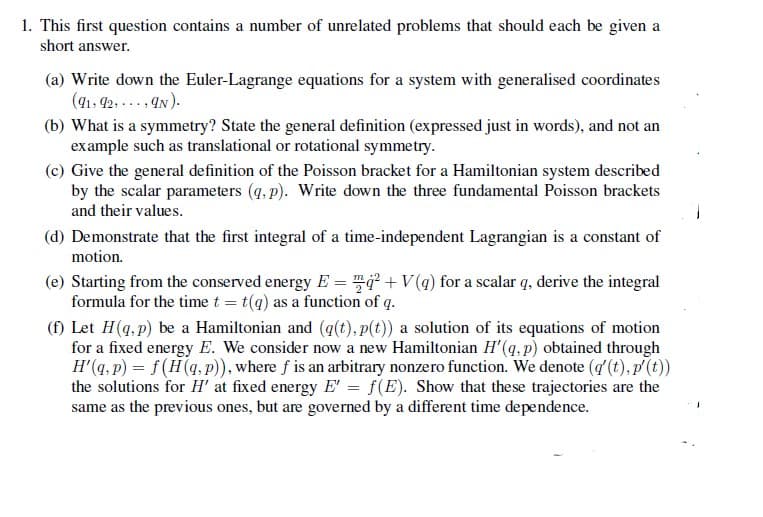1. This first question contains a number of unrelated problems that should each be given a short answer. (a) Write down the Euler-Lagrange equations for a system with generalised coordinates (91. 42, -..,AN). (b) What is a symmetry? State the general definition (expressed just in words), and not an example such as translational or rotational symmetry. (c) Give the general definition of the Poisson bracket for a Hamiltonian system described by the scalar parameters (q, p). Write down the three fundamental Poisson brackets and their values. (d) Demonstrate that the first integral of a time-independent Lagrangian is a constant of motion. (e) Starting from the conserved energy E = +V(q) for a scalar q, derive the integral formula for the time t = t(q) as a function of q. (f) Let H(q, p) be a Hamiltonian and (q(t), p(t)) a solution of its equations of motion for a fixed energy E. We consider now a new Hamiltonian H'(q, p) obtained through H'(q, p) = f(H(q,P)). where f is an arbitrary nonzero function. We denote (q(t),p(t)) the solutions for H' at fixed energy E' = f(E). Show that these trajectories are the same as the previous ones, but are governed by a different time dependence.
1. This first question contains a number of unrelated problems that should each be given a short answer. (a) Write down the Euler-Lagrange equations for a system with generalised coordinates (91. 42, -..,AN). (b) What is a symmetry? State the general definition (expressed just in words), and not an example such as translational or rotational symmetry. (c) Give the general definition of the Poisson bracket for a Hamiltonian system described by the scalar parameters (q, p). Write down the three fundamental Poisson brackets and their values. (d) Demonstrate that the first integral of a time-independent Lagrangian is a constant of motion. (e) Starting from the conserved energy E = +V(q) for a scalar q, derive the integral formula for the time t = t(q) as a function of q. (f) Let H(q, p) be a Hamiltonian and (q(t), p(t)) a solution of its equations of motion for a fixed energy E. We consider now a new Hamiltonian H'(q, p) obtained through H'(q, p) = f(H(q,P)). where f is an arbitrary nonzero function. We denote (q(t),p(t)) the solutions for H' at fixed energy E' = f(E). Show that these trajectories are the same as the previous ones, but are governed by a different time dependence.
Classical Dynamics of Particles and Systems
5th Edition
ISBN:9780534408961
Author:Stephen T. Thornton, Jerry B. Marion
Publisher:Stephen T. Thornton, Jerry B. Marion
Chapter7: Hamilton's Principle-lagrangian And Hamiltonian Dynamics
Section: Chapter Questions
Problem 7.32P
Related questions
Question
ans d

Transcribed Image Text:1. This first question contains a number of unrelated problems that should each be given a
short answer.
(a) Write down the Euler-Lagrange equations for a system with generalised coordinates
(41, 42, ... , AN).
(b) What is a symmetry? State the general definition (expressed just in words), and not an
example such as translational or rotational symmetry.
(c) Give the general definition of the Poisson bracket for a Hamiltonian system described
by the scalar parameters (q, p). Write down the three fundamental Poisson brackets
and their values.
(d) Demonstrate that the first integral of a time-independent Lagrangian is a constant of
motion.
(e) Starting from the conserved energy E = +V(q) for a scalar q, derive the integral
formula for the time t = t(q) as a function of q.
(f) Let H(q, p) be a Hamiltonian and (q(t), p(t)) a solution of its equations of motion
for a fixed energy E. We consider now a new Hamiltonian H'(q, p) obtained through
H'(q, p) = f(H(q,P)), where f is an arbitrary nonzero function. We denote (g'(t), p(t))
the solutions for H' at fixed energy E' = f(E). Show that these trajectories are the
same as the previous ones, but are governed by a different time dependence.
Expert Solution
This question has been solved!
Explore an expertly crafted, step-by-step solution for a thorough understanding of key concepts.
Step by step
Solved in 3 steps with 3 images

Knowledge Booster
Learn more about
Need a deep-dive on the concept behind this application? Look no further. Learn more about this topic, physics and related others by exploring similar questions and additional content below.Recommended textbooks for you

Classical Dynamics of Particles and Systems
Physics
ISBN:
9780534408961
Author:
Stephen T. Thornton, Jerry B. Marion
Publisher:
Cengage Learning

Classical Dynamics of Particles and Systems
Physics
ISBN:
9780534408961
Author:
Stephen T. Thornton, Jerry B. Marion
Publisher:
Cengage Learning